Reading Test Prep – Example Questions
How do reading tests assess the sub-skills needed to become a proficient reader?
Here are just some ways schools evaluate the sub-skills needed for reading mastery through various reading tests.
1. Letter-Sound Knowledge:
- Recognition of Upper- and Lower-Case Letters and Their Sounds
Example: Which letter is M? Choose the letter M.

Answer: 2 – m
- Identification of Common 2-Letter Combinations with Single Sounds (e.g., ch, sh, kn, ea, oa).
Example: Which letter is the vowel sound in the word “man?”
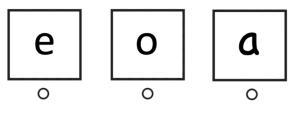
Answer: 3 – a
- Identification of Common Blends Pronounced as Spelled (e.g., sp, nt).
Example: The word is “chair.” What are the first 2 letters in the word “chair?”
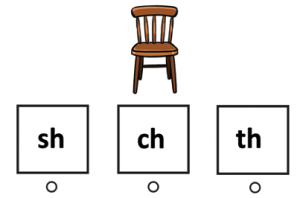
Answer: 2 – ch
Want to try us out? Sign up for a free account today and get 100 practice questions.
2. Phonological and Phonemic Awareness (these terms are often used interchangeably) – this always relates to the sound of oral language.
Phonological Awareness is the ability to recognize and manipulate the spoken parts of words – i.e., rhymes, alliteration, syllables.
Phonemic Awareness is the ability to notice, think about, and work with individual sounds (phonemes) in spoken words.
- Rhyming or Rhyme Recognition
Example: Choose the picture that does not rhyme with…see.
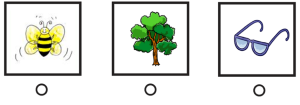
Answer: 3 – glasses
- Substitution
Example: If you take the /a/ sound in bat and change it to an /e/ sound, what will the new word be?

Answer: 2 – bet
- Segmentation
Example: How many syllables are in this word?
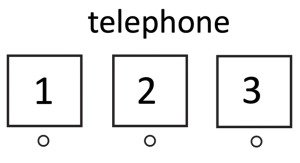
Answer: 3 – tel / e / phone
- Isolation
Example: In which word does the vowel “u” sound the same way it sounds in the word “puddle?”

Answer: 1 – buzz
To access a more comprehensive breakdown of the question types and the sub-skills evaluated in a Reading Test, you can subscribe and become a TestingMom.com member! To get a sneak peak, access 100 Free Practice Questions Today!
3. Phonics is the understanding of the relationship between letter sounds and printed words. Assessing phonics mastery often involves testing with “nonsense” or “pseudo” words that follow phonetic rules. Timed assessments gauge how quickly students can use phonics decoding skills to pronounce unfamiliar words, reflecting their phonics proficiency.
Example 1: Say to your child: “Look at the words inside the box. They are silly (or nonsense) words without any meaning. Please read each word in the box to me when I say go. Ready, set, go!” (Give your child 30 seconds to read all 6 words.)
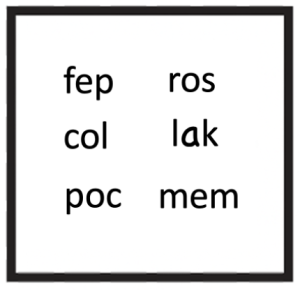
Example 2: Give your child lined paper and a pencil. You will ask your child to spell a word, then you will say a sentence that uses the spelling word. Tell your child to print the word on the paper. This type of reading subtest assesses both phonics knowledge, spelling, and writing.
- Spell the word “it.” “Come and get it.”
- Spell the word “cat.” “My cat is black.”
- Spell the word “fun.” “We had fun at the park.”
4. Orthographic Knowledge is a person’s understanding of spelling, letter-sound relationships, and word recognition in written language. It’s crucial for reading and writing skills. Orthographic mapping is the process of connecting how words look with their pronunciation and meaning to enhance reading fluency.
Example 1: Choose the word that is spelled correctly.

Answer: 2 – piece
Example 2: Say to your child: “Look at the words inside the box. Read each word out loud in the box to me when I say go. Ready, set, go!”
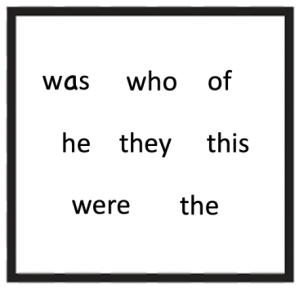
Note: None of the words in this box sound the way they are spelled, which is why they must be memorized – they can’t be sounded out. This type of reading subtest is also an assessment of word-level reading fluency.
Want to try us out? Sign up for a free account today and get 100 practice questions.
5. Spelling, phonics decoding, and orthographic mapping are strongly connected. If a child can spell a word, they can usually read it. Most spelling tests also assess orthographic knowledge. Here are some ways that spelling is assessed:
Example 1: Choose the word that is spelled correctly.

Answer: 3 – interesting
Example 2: Your child will be asked to write down spelling words. Another way to practice these questions would be to have your child recite the spelling of the word out loud.
- Spell the word “those.” “Put those away.”
- Spell the word “drowsy.” “It is late, and I am drowsy.”
- Spell the word “sauce.” “Please pass the chocolate sauce.”
6. Fluency in reading refers to the ability to read text smoothly and quickly, while also pronouncing words accurately and using appropriate voice intonation. It’s assessed through methods like Rapid Automatic Naming (RAN) tests, where individuals rapidly name items from an array, and by having students read aloud at the word, sentence, and passage level. The goal is to ensure that individuals can read with ease, allowing them to focus on comprehension rather than struggling with word recognition.
Example 1: Rapid Automatic Naming (RAN)
Students are given 5 minutes and asked to go through the pictures in order and say its color and what it is. For example: red car, blue apple, red teddy bear, blue car…

Example 2:
Students see a list of 100+ sentences. They must read them as quickly as possible and decide if they are true or false. This subtest assesses sentence-reading fluency and reading comprehension.
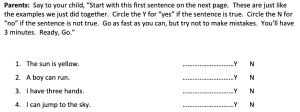
Example 3:
Students see 200 rows of words. They must go down each row and combine the first word with a second word to make a new word. They are given 3 minutes to get as far as they can through the rows.
Sample:
honey plane bird up bee
Answer: bee (honeybee)
Parents Say: Go as fast as you can but try to make as many new words as you can. I’ll tell you when to stop. Ready…go!
- black time bird go cake
- to moon eye day in
- snow man boy cold ice
Answers: bird (blackbird), day (today), man (snowman)
Example 4:
This portion will test a student’s reading fluency. Younger students will read sentences and older students will read paragraphs aloud. Students are scored on a scale of 1 to 4 based on their reading quality:
Level 1: Non-fluent Reader (Word-by-word, hesitant, errors)
Level 2: Non-fluent Reader (Some flow, tone issues, errors)
Level 3: Fluent Reader (Flow, punctuation, accuracy)
Level 4: Fluent Reader (Smooth, expressive, high accuracy)
Errors are counted for mispronunciations, omissions, substitutions, reversals, and hesitations of 4 seconds or more. This assessment helps identify areas for improvement in reading skills.
Here’s a sample of what a 2nd grade students would be asked to read aloud:
“There were so many things that I couldn’t stand about him. The worst was that he was always telling me he could do just about everything better than I.”
To access additional passages, practice questions, and information about the scoring of reading fluency, you can join TestingMom.com as a member! Access 100 Free Practice Questions Today!
7. Vocabulary refers to words we understand when we hear them, say them, read them, or write them.
Example 1:
Students are shown pictures and asked what the picture is called.

Answer: tiger, whistle, ear
Example 2:
Students are asked to say the opposite of a word (demonstrating that they know the meaning of the word).
Choose the word that means the opposite of…friend.

Answer: 1 – enemy
Example 3:
Students are asked to choose a word that could replace an underlined word in a sentence (demonstrating that they know the meaning of the word).
Read the passage. Then choose the word that means the same thing as the word that has been underlined and could replace that word.
Jan’s mom asked her, “Why do you always run? Why are you in a hurry?”
“I’m not in a hurry,” said Jan. “I just love to run!”

Answer: 3 – rush
Example 4:
Students are asked to choose a word that that means the same thing as another word (demonstrating that they know the meaning of the word).
Choose the word that means discomfort.

Answer: 3 – pain
Example 5:
After a student reads a passage on a Reading Comprehension subtest, they are asked the meaning of a word in a particular paragraph. Often the student must look at the words around the vocabulary word to determine context and ultimate meaning.
What word means nearly the same as “impressive” in the 1st paragraph?
- large
- common
- typical
- influential
8. Comprehension refers to understanding and interpreting what you read on a page. Comprehension is the process of deciphering what you read and being able to actively engage with the text.
Example 1: Choose the word that best completes the sentence.
It is important to _____ after you exercise.

Answer: 3 – stretch
Example 2:
Parents say: “Listen to the story I read to you.”
Amy was playing ball with Sue near the playground during recess. When the teacher blew the whistle, they took turns carrying the ball back into the school. Amy put it away in the box by the door.
Parents say: “Retell me the story I just read to you.”
Example 3:
Reading Comprehension Section – This will assess a student’s ability to understand a passage at their grade level. They typically include questions about the main idea, details, word meanings, inferences, and may be presented as multiple-choice or oral questions. These tests are essential for evaluating reading skills and guiding instruction.
To access additional passages, practice questions, and information about vocabulary and reading comprehension, you can join TestingMom.com as a member! Access 100 Free Practice Questions Today!
9. Writing tests assess a student’s ability to write letters, words, or sentences.
Example 1: The student is asked to write a letter or work on lined paper.
Parents say: “I’m going to tell you a letter and the sound the letter makes. Then you write the letter/word on this piece of paper. F as in fun.”

Example 2: The student is asked to show that they know what a letter looks like, and then how to write it.
Parents: Draw a lower case “d” and a lower case “e.” Give your child a pencil and say, “Look at these two letters. The first is a small or lower case ‘d.’ The second is a small or lower case ‘e.’ Can you make a lower case ‘h’ as in hat?”

Example 3: The student is asked to complete a sentence by writing in the correct word after seeing a picture. This assesses both writing and vocabulary.

Answer: brown dog (color answer may vary but within reason)
How Are Reading Tests Scored
Most reading tests provide a variety of normative scores: age equivalents, grade equivalents, percentile ranks, subtest scaled scores, composite indexes, and developmental scores.
To access additional writing practice questions and information about how reading tests are scored, you can join TestingMom.com as a member! Access 100 Free Practice Questions Today!
See if TestingMom.com supports your child’s test by your school district. If you don't see your child's school district listed, check with us! We have practice for other tests as well.



Tell us about your experiences